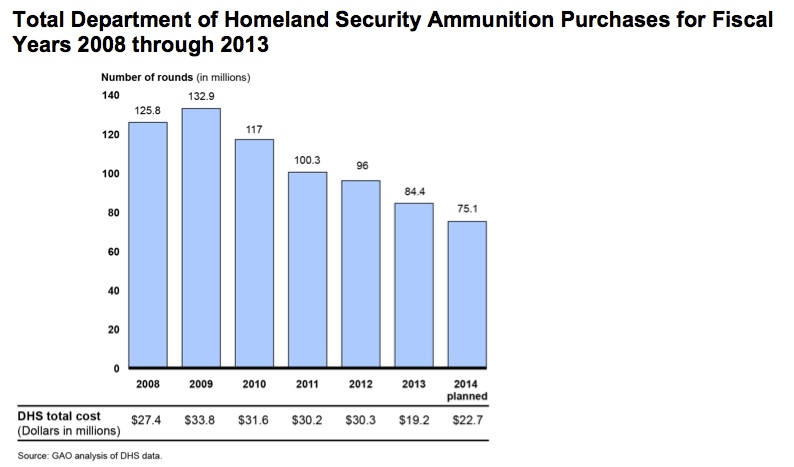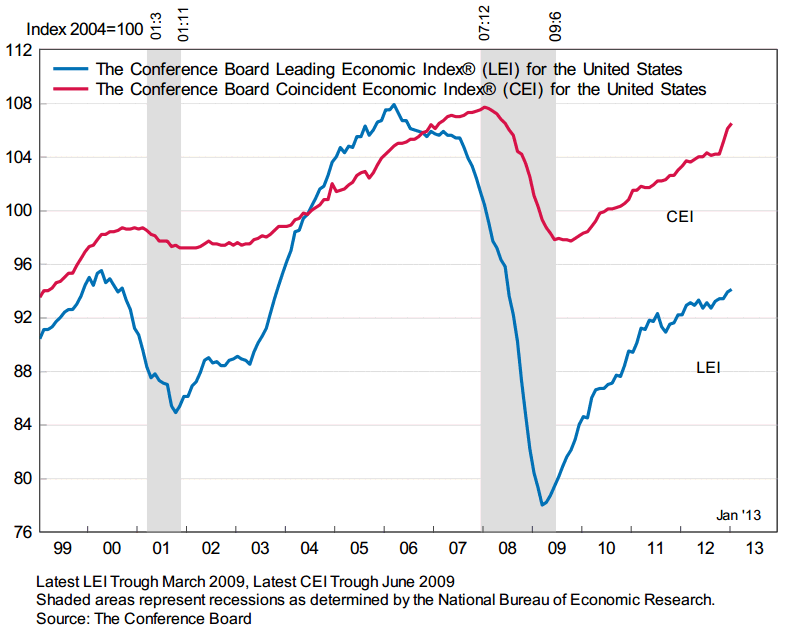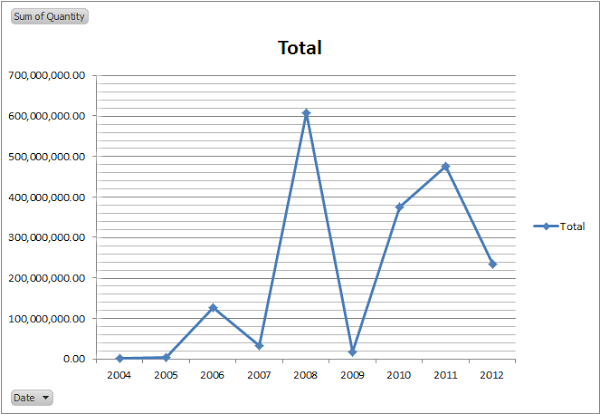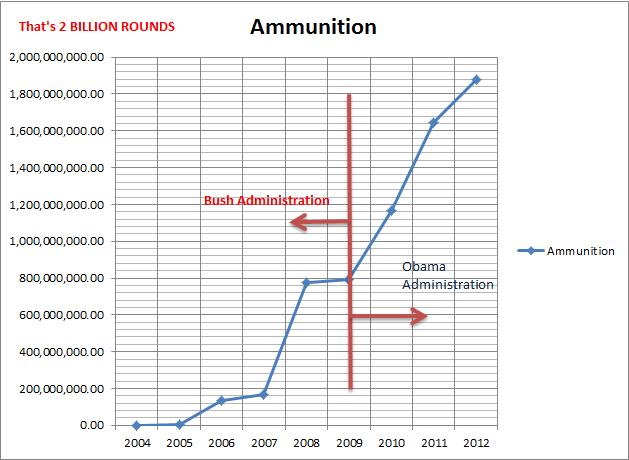The final nail in the coffin of the already widely debunked theory that the government (specifically the Department of Homeland Security) is stockpiling unusually large amounts of ammo (presumably to prepare for some great civil unrest) comes in the form of a GAO report requested by Senator Tom Coburn and others, released today
The bottom line:

http://www.coburn.senate.gov/public...-dhs-ammunition-purchases-declined-since-2009 (http://archive.is/fktwx)
http://www.gao.gov/products/GAO-14-119 (http://archive.is/r88Jd)
The bottom line:
- The DHS makes ammunition purchases aimed at minimizing cost
- The ammo is used almost entirely in training, at an average rate of 110 Million rounds a year
- The large figures quoted are the upper limits for open ended multi-year contracts
- Actual purchases of physical ammo have declined, not increased

http://www.coburn.senate.gov/public...-dhs-ammunition-purchases-declined-since-2009 (http://archive.is/fktwx)
The report:
Feb 12 2014
New GAO Report Finds DHS Ammunition Purchases Declined Since 2009^
(WASHINGTON, D.C.) – U.S. Senator Tom Coburn, M.D. (R-OK), ranking member of the Homeland Security and Governmental Affairs Committee, today highlighted a new report^ from the Government Accountability Office (GAO) that examines ammunition procurement practices at the Department of Homeland Security. The report found that since 2009, ammunition purchases at the department have declined. DHS currently has more than 70,000 firearm-carrying personnel.
“Today’s GAO report provides much-needed oversight into DHS’s ammunition procurement practices,” Dr. Coburn said. “Specifically, the GAO looked at DHS’s history of ammunition purchases and found that purchases have declined considerably since 2009. The GAO also highlighted a number of positive safeguards DHS uses in its procurement practices such as strategic sourcing in order to secure the lowest prices for ammo. I am pleased DHS has worked in good faith, and in a transparent manner, with both myself and the GAO. I will continue to conduct rigorous oversight of DHS programs and will specifically work with Congress and the GAO to examine how duplicative federal police forces cause excess and waste across the federal government.”
Dr. Coburn’s previous oversight work on DHS ammunition purchases can be found here^.
House Homeland Security Committee Chairman Michael McCaul and House Subcommittee on Oversight and Management Efficiency Chairman Jeff Duncan were lead requestors on the report.
Findings include:
- Overall, the GAO found that DHS ammunition purchases have declined since 2009 as the chart illustrates below:
- From fiscal years 2008 through 2013, DHS purchased an average of 109 million rounds of ammunition for training, qualification, and operational needs. This 6 year period equates to an average of 1,200 rounds of ammunition purchased per firearm-carrying officer per year.
- According to DHS contract data, as of October 2013, 29 ammunition contracts existed which have a remaining balance of around 704 million rounds. These contracts have a contract dollar ceiling of around $285 million.
- In August 2012, DHS required components to use strategic sourcing contract vehicles for procurements, which include ammunition. DHS officials believe that the strategic sourcing process for ammunition has saved an estimated $2 million since 2008.
http://www.gao.gov/products/GAO-14-119 (http://archive.is/r88Jd)
(full report attached)
What GAO Found
The Department of Homeland Security's (DHS) annual ammunition purchases have declined since fiscal year 2009 and are comparable in number to the Department of Justice's (DOJ) ammunition purchases. In fiscal year 2013, DHS purchased 84 million rounds of ammunition, which is less than DHS's ammunition purchases over the past 5 fiscal years, as shown in the figure below. DHS component officials said the decline in ammunition purchases in fiscal year 2013 was primarily a result of budget constraints, which meant reducing the number of training classes, and drawing on their ammunition inventories. From fiscal years 2008 through 2013, DHS purchased an average of 109 million rounds of ammunition for training, qualification, and operational needs, according to DHS data. DHS's ammunition purchases over the 6-year period equates to an average of 1,200 rounds purchased per firearm-carrying agent or officer per year. Over the past 3 fiscal years (2011-2013), DHS purchased an average of 1,000 rounds per firearm-carrying agent or officer and selected DOJ components purchased 1,300 rounds per firearm-carrying agent or officer.
DHS ammunition purchases are driven primarily by firearm training and qualification requirements. Most DHS firearm-carrying personnel are required to qualify four times per year, though requirements vary by component, as do the number of rounds of ammunition typically used for training and qualification. DHS components also reported considering other factors when making ammunition purchase decisions, such as changes in firearms, usage rates, and ammunition inventories. DHS components maintain inventories of ammunition to help ensure they have sufficient ammunition for the training and operational needs of their officers, as there can be months-long delays between placing an order for ammunition and receiving it. As of October 2013, DHS estimates it had approximately 159 million rounds in inventory, enough to last about 22 months to meet the training and operational needs of its firearm-carrying personnel. Ammunition inventory data provided by DOJ components indicated that inventory ranged from about 13 months' worth to about 20 months' worth.
Why GAO Did This Study
DHS and its components have homeland security and law enforcement missions that require agents and officers to carry and be proficient in the use of firearms. DHS has more than 70,000 firearm-carrying personnel—the most of any department. DOJ has the next largest with approximately 69,000 firearm-carrying personnel. GAO was asked to examine DHS's ammunition purchases and management of ammunition and firearms. This report addresses trends in DHS's ammunition purchases since fiscal year 2008, how DHS's purchases compare with DOJ's, and what factors affect DHS's purchase decisions. GAO analyzed data from six DHS and three DOJ components that have law enforcement missions, require agents and officers to carry firearms, and purchase ammunition themselves or through their respective departments. Specifically, GAO analyzed data on ammunition purchases, usage, costs, and inventories, among other things, for fiscal years 2008 through 2013 for DHS, and for fiscal years 2011 through 2013 for DOJ. GAO assessed the reliability of these data and found them sufficiently reliable. Data on DOJ ammunition purchases prior to fiscal year 2011 were not readily available; therefore, GAO excluded them, as discussed in the report.
What GAO Recommends
GAO is not making any recommendations.



 How accurate is this ?
How accurate is this ?